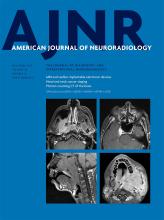We appreciate the comments from Drs Shin and Kim regarding our publication, “Perfusion MR Imaging Using a 3D Pulsed Continuous Arterial Spin-Labeling Method for Acute Cerebral Infarction Classified as Branch Atheromatous Disease Involving the Lenticulostriate Artery Territory.”1
It is well-established that branch atheromatous disease (BAD) is a risk factor for early neurologic deterioration (END).2⇓⇓–5 Jeong et al2 reported that the baseline NIHSS score in patients with a single small subcortical infarction, including BAD, cannot predict END, whereas another article showed that the baseline NIHSS score in patients with BAD can predict END.3 Therefore, we focused on the initial MR imaging findings of lenticulostriate artery (LSA)-type BAD in comparison with the baseline NIHSS score. To our knowledge, only a few reports thus far have referred to the association between DWI infarct volume and clinical outcome in patients having radiologically defined LSA-type BAD.4,5 Because the clinical entity, including the radiologic definition of BAD, remains uncertain, further investigations are needed to prove the relationship between the imaging characteristics of BAD and END.5
Regarding the collinearity between asymmetry index of the contralateral cerebellar hemisphere (crossed cerebellar diaschisis, AICCD) on 3D-arterial spin-labeling (ASL) and DWI infarct volume, we also considered that it would be better to perform multivariable regression analysis to clarify the relationship. However, our sample size was not large enough to obtain reliable statistical data. The Pearson correlation coefficient was used to compare the admission NIHSS score with each AICCD and infarct volume for the same reason. These decisions about the methods were based on statistical consultation with a specialist.
In addition, we previously reported the correlation between AICCD on 3D-ASL and the initial NIHSS score in patients with cardioembolic infarction (CE, n = 44) and large-artery atherosclerosis (LAA, n = 38) as well as LSA-type BAD at the 46th Annual Meeting of the Japanese Society of Neuroradiology, February 17–19, 2017, Tokyo, Japan. Our findings revealed that there was no significant correlation between AICCD and the initial NIHSS score in CE or LAA (r = 0.147, P = .340; r = 0.086, P = .606, respectively). Although LSA-type BAD usually affects the pyramidal tract at the corona radiata or internal capsule, easily resulting in a remote effect along the corticopontocerebellar pathway, the ischemic lesions of CE and LAA might be more variable depending on the collateral status or vascular territories compared with the LSA-type BAD.
Finally, as noted by Drs Shin and Kim, the main message of our study was that acute LSA-type BAD can show crossed cerebellar diaschisis on 3D-ASL and there is a significant correlation between the degree of perfusion asymmetry of crossed cerebellar diaschisis and initial neurologic severity. Further studies are warranted to validate the relationship between AICCD and neurologic outcome, including follow-up NIHSS score, and to clarify the collinearity between AICCD and baseline lesion volume with a larger sample size.
References
- © 2017 by American Journal of Neuroradiology












